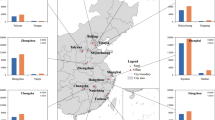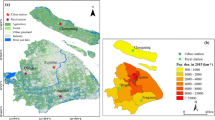Abstract
Chinese New Year (CNY), or Spring Festival, is the most important of all festivals in China. We use daily observations to show that Beijing’s urban heat island (UHI) effects largely depend on precipitation, cloud cover, and water vapor but are insensitive to wind speed, during the CNY holiday season. Non-precipitating, clear, and low humidity conditions favor strong UHI effects. The CNY holiday, with some 3 billion journeys made, provides a living laboratory to explore the role of population movements in the UHI phenomenon. Averaged over the period 2004–2013, with the Olympic year of 2008 excluded, Beijing’s UHI effects during the CNY week decline by 0.48 °C relative to the background period (4 weeks including 2 to 3 weeks before, and 2 to 3 weeks after, the CNY week). With combined effects of precipitation, large cloud cover, and high water vapor excluded, the UHI effects during the CNY week averaged over the study period decline by 0.76 °C relative to the background period, significant at the 99% confidence level by Student’s t test. These results indicate that the impacts of population movements can be more easily detected when excluding unfavorable meteorological conditions to the UHI. Population movements occur not only during the CNY holiday, but also during all the time across the globe. We suggest that better understanding the role of population movements will offer new insight into anthropogenic climate modifications.






Similar content being viewed by others
References
Arnfield AJ (2003) Two decades of urban climate research: a review of turbulence, exchanges of energy and water, and the urban heat island. Int J Climatol 23:1–26
Bonan GB (2008) Ecological Climatology, 2nd edn 550 pp. Cambridge Univ Press, Cambridge, U.K.
Bounoua L, Zhang P, Mostovoy G et al. (2015) Impact of urbanization on US surface climate. Environ Res Lett 10 doi:10.1088/1748-9326/10/8/084010
Chu Z, Ren G (2005) Effect of enhanced urban heat island magnitude on average surface air temperature series in Beijing region (in Chinese). Acta Meteorologica Sinica 63:534–540
Georgescu M, Moustaoui M, Mahalov A, Dudhia J (2013) Summer-time climate impacts of projected megapolitan expansion in Arizona. Nature Clim Change 3:37–41
Grimm NB, Faeth SH, Golubiewski NE, Redman CL, Wu J, Bai X, Briggs JM (2008) Global change and the ecology of cities. Science 319:756–760
Howard L (1833) The climate of London. Vol 1–3. Harvey and Dorton, London 1002pp
Jin M, Dickinson RE, Zhang D (2005) The footprint of urban areas on global climate as characterized by MODIS. J Clim 18:1551–1565
Kalnay E, Cai M (2003) Impact of urbanization and land-use change on climate. Nature 423:528–531
Li Q, Zhang H, Liu X, Huang J (2004) Urban heat island effect on annual mean temperature during the last 50 years in China. Theor Appl Climatol 79:165–174
Liu W, Ji C, Zhong J, Jiang X, Zheng Z (2007) Temporal characteristics of the Beijing urban heat island. Theor Appl Climatol 87:213–221
Mahmood R, Pielke RA Sr, Hubbard KG et al (2014) Land cover changes and their biogeophysical effects on climate. Int J Climatol 34:929–953
Martin-vide J, Sarricolea P, Moreno-Garcia MC (2015) On the definition of urban heat island intensity: the "rural" reference. Front Earth Sci 3. doi: 10.3389/feart.2015.00024
Memon R, Leung D, Liu C et al (2011) Urban heat island and its effect on the cooling and heating demands in urban and suburban areas of Hong Kong. Theor Appl Climatol 103:441–450
Miao S, Chen F, LeMone MA, Tewari M, Li Q, Wang Y (2009) An observational and modeling study of characteristics of urban heat island and boundary layer structures in Beijing. J Appl Meteorol 48:484–501
Mirzaei PA (2015) Recent challenges in modeling of urban heat island. Sustainable and Society. doi:10.1016/j.scs.2015.04.001
Myhre GD, Shindell D, Bréon F-M et al (2013) Anthropogenic and natural Radiative forcing. In: Stocker TF, Qin D, Plattner G-K, Tignor M, Allen SK, Boschung J, Nauels A, Xia Y, Bex V, Midgley PM (eds) Climate change 2013: the physical science basis. Contribution of working group I to the fifth assessment report of the intergovernmental panel on climate change. Cambridge University Press, Cambridge, United Kingdom and New York, NY, USA, pp 659–740. doi:10.1017/ CBO9781107415324.018
Oleson KW, Bonan GB, Feddema J, Jackson T (2011) An examination of urban heat island characteristics in a global climate model. Int J Climatol 31:1848–1865
Oke TR (1982) The energetic basis of the urban heat island. Quart J Roy Meteor Soc 108:1–24
Ren G, Chu Z, Chen Z, Ren Y (2007) Implications of temporal change in urban heat island intensity observed at Beijing and Wuhan stations. Geophys Res Lett 34:L05711. doi:10.1029/2006GL027927
Ren G, Zhou Y, Chu Z et al (2008) Urbanization effects on observed surface air temperature trends in North China. J Clim 21:1333–1348
Ren Y, Ren G (2011) A remote-sensing method of selecting reference stations for evaluating urbanization effect on surface air temperature trends. J Clim 24:3179–3189
Rosenzweig C, Solecki WD, Parshall L et al (2009) Mitigating New York City's heat island: integrating stakeholder perspectives and scientific evaluation. Bull Am Meteorol Soc 90:1297–1312
Sachindra DA, Ng AWM, Muthumaran S, Perera BJC (2015) Impact of climate change on urban heat island effect and extreme temperatures: a case study. Q J R Meteorol Soc 141: doi: 10.1002/qj.2642.
Stewart ID, Oke TR (2012) Local climate zones for urban temperature studies. Bull Amer Meteor Soc 93:1879–1900
Taha H (1997) Urban climates and heat islands: albedo, evapotranspiration, and anthropogenic heat. Energy and Building 25:99–103
Taha H (2015) Meteorological, air-quality, and emission-equivalence impacts of urban heat island control in California. Sustainable Cities and Society. doi:10.1016/j.scs.2015.03.009
UN DESA Population Division (2014) World urbanization prospects: the 2014 revision. United Nations Department of Economic and Social Affairs (UN DESA) Population Division, New York, NY, USA
Wang J, Yan Z, Li Z, Liu W, Wang Y (2013) Impact of urbanization on changes in temperature extremes in Beijing during 1978-2008. Chin Sci Bull 58:4679–4686
Weaver C, Cooter E, Gilliam R et al (2009) A preliminary synthesis of modeled climate change impacts on U. S. regional ozone concentrations. Bull Amer Meteor Soc 90:1843–1863
Wu K, Yang X (2013) Urbanization and heterogeneous surface warming in eastern China. Chi Sci Bull 58(12):1363–1373
Wu L, Zhang J, Shi C (2015) Mass human migration and the urban heat island during the Chinese New Year holiday: a case study in Harbin City, Northeast China. Atmos Oceanic Lett 8:63–66
Yan Z, Li Z, Li Q, Jones P (2010) Effects of site change and urbanisation in the Beijing temperature series 1977-2006. Int J Climatol 30:1226–1234
Yang K (2015) Population distribution and multicenter measurement of great Beijing. China Population, Resources and Environment 25:83–89
Yang P, Ren G, Liu W (2013) Spatial and temporal characteristics of Beijing urban heat island intensity. J Appl Meteorol 52:1803–1816
Zhao L, Lee X, Smith RB, Oleson K (2014) Strong contributions of local background climate to urban heat island. Nature 511:216–219
Zhang G, Xu X, Wang J, Yang Y (2002) A study of characteristics and evolution of urban heat island over Beijing and its surrounding area. J Appl Meteor Sci 13:43–50 (in Chinese)
Zhang J, Zhang X, Wang X et al (2010) Time scale analysis of temperature and its urban heat island effect in Beijing. Arid Land Geography 33:51–58
Zhang J, Wu L (2015) Modulation of the urban heat island by the tourism during the Chinese New Year holiday: a case study in Sanya City, Hainan Province of China. Chin Sci Bull 60. doi: 10.1007/s11434-015-0864-2
Zhang, J, Wu L (2016) A New view of human impacts on the climate: the role of population movements. Sci Bull 61. doi: 10.1360/N972015-01079. (in Chinese)
Zhang J, Wu L, Yuan F, Dou J, Miao S (2015) Mass human migration and Beijing's urban heat island during the Chinese New Year holiday. Sci Bull 60:1038–1041
Zhou L, Dickinson R, Tian Y, Fang J, Li Q, Kaufmann R, Tucker C, Myneni R (2004) Evidence for a significant urbanization effect on climate in China. Proc Natl Acad Sci U S A 101:9540–9544
Acknowledgements
This work was supported by the National Natural Science Foundation of China (Grant Nos. 41675085,41275089 and 41305071).
Author information
Authors and Affiliations
Corresponding author
Rights and permissions
About this article
Cite this article
Wu, L., Zhang, J. Assessing population movement impacts on urban heat island of Beijing during the Chinese New Year holiday: effects of meteorological conditions. Theor Appl Climatol 131, 1203–1210 (2018). https://doi.org/10.1007/s00704-017-2043-7
Received:
Accepted:
Published:
Issue Date:
DOI: https://doi.org/10.1007/s00704-017-2043-7




